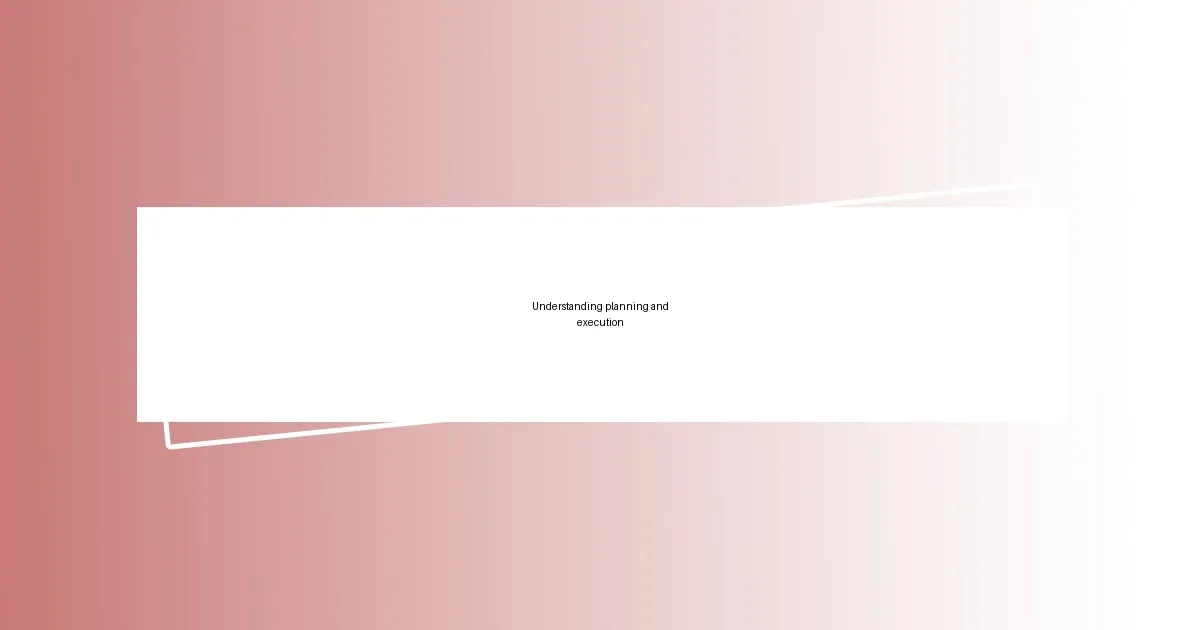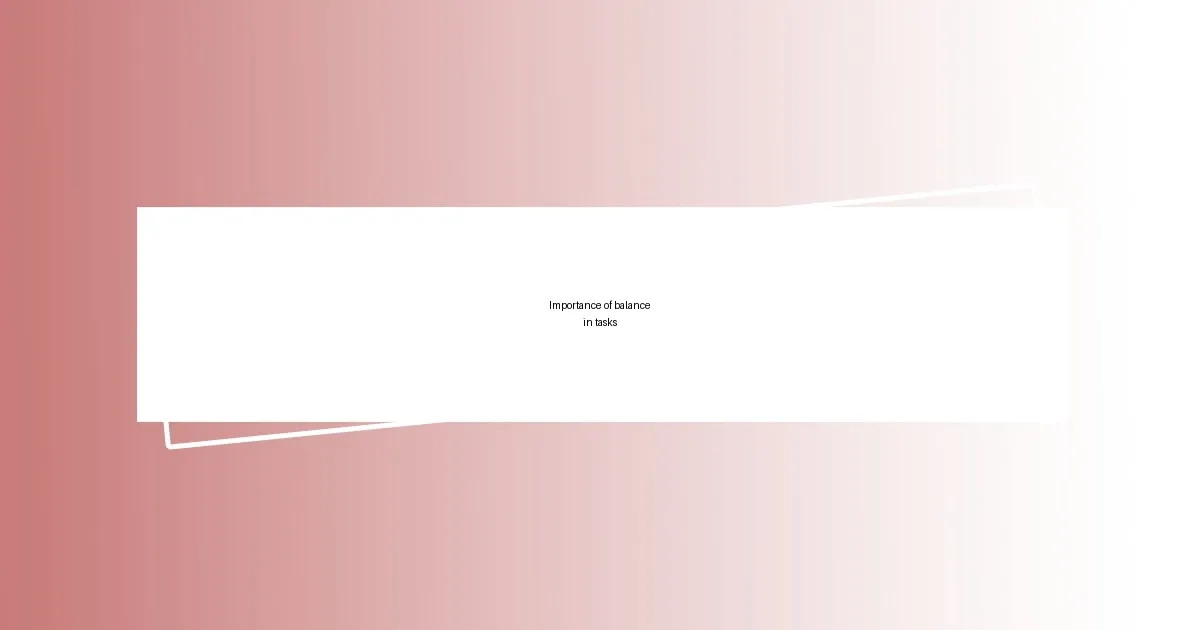Key takeaways:
- Effective balance between planning and execution is crucial for optimal productivity, with each phase complementing the other.
- Implementing clear, achievable goals and utilizing tools like Trello and Asana enhances planning and tracking progress.
- Regular check-ins and maintaining flexibility during execution allow for real-time adjustments, ensuring project success.
- Regularly reviewing and adjusting plans, along with incorporating team feedback, fosters continuous improvement and innovative solutions.

Understanding planning and execution
Planning and execution are two sides of the same coin, shaping how we turn ideas into reality. I often find myself reflecting on the time I carefully mapped out a marketing campaign, only to realize the importance of flexibility during execution. Have you ever felt overwhelmed by a meticulously laid-out plan that suddenly crumbled in the face of unanticipated challenges? That’s where adaptability becomes key.
Execution is where the magic happens, but without a solid plan, it can feel like sailing a ship without a rudder. I remember launching a project where I dove straight into execution, only to discover essential elements of the plan had been overlooked. It’s a harsh lesson, but it taught me that planning provides the framework, while execution breathes life into those ideas. How do we strike that balance?
Understanding the nuances in planning and execution is crucial for success. I’ve learned that while it’s tempting to push ahead with execution, taking a step back to evaluate and adjust our approach can pay off immensely. Isn’t it fascinating how sometimes the most powerful insights emerge when we pause and reflect? This duality continually shapes not just my workflow but also my perspective on achieving my goals.

Importance of balance in tasks
Finding the right balance in tasks is essential for optimal productivity. I recall a time when I was caught in the excitement of executing a new project, often skipping planning stages. The outcome? A chaotic situation that required hours of fixing preventable mistakes. It was a tough wake-up call, underscoring how vital it is to ensure planning aligns seamlessly with execution.
I’ve noticed that balance acts like a seesaw, with planning on one side and execution on the other. When one outweighs the other, it creates instability. For instance, during a recent event I organized, I invested a lot of time in planning but neglected to adapt during execution. The moment circumstances shifted, I felt the pressure mounting. By recalibrating my focus on responding dynamically, I regained control and delivered a successful event.
Ultimately, balancing these tasks cultivates a sense of harmony and clarity. It allows me to feel more confident and less stressed, knowing I have both a solid plan and the capacity to adapt as needed. Does that resonate with you? I’ve found this balance opens up endless opportunities for growth and success, as it paves the way for continuous improvement.
| Planning | Execution |
|---|---|
| Provides a roadmap | Brings plans to life |
| Focuses on details | Requires adaptability |
| Sets clear goals | Responds to challenges |

Strategies for effective planning
When it comes to effective planning, one of the most valuable strategies I’ve embraced is setting clear, achievable goals. I vividly remember a project where I aimed for a massive outcome without breaking it down into smaller, manageable milestones. As a result, I became overwhelmed and lost track. It was only when I started defining specific goals, each with its own timeline, that I began to see real progress. It felt like climbing a mountain: one step at a time, and soon enough, I was enjoying the view from the top.
Here are some strategies that have helped me streamline my planning process:
- Identify Priorities: Focus on what’s truly important to avoid getting bogged down by less essential tasks.
- Utilize Tools: A good project management tool can provide visual clarity and keep you on track.
- Embed Flexibility: Life happens, so ensure your plan allows for adjustments without derailing the overall vision.
- Reflect and Revise: Take time to evaluate past successes and setbacks, using those insights to refine future planning.
- Involve Others: Engaging team members in the planning process can provide diverse perspectives and bolster commitment.
By implementing these strategies, I’ve noticed my planning becoming more organized and aligned with execution. This not only eases my uncertainty but also enhances my confidence. It’s a truly empowering feeling!

Techniques for seamless execution
One technique I’ve found invaluable for seamless execution is the practice of regular check-ins. When I led a fundraising campaign last year, I scheduled weekly meetings with my team to assess our progress and tackle any emerging issues. These check-ins acted as a safety net, allowing us to pivot quickly when something wasn’t working. Have you ever experienced a project veering off-course? By fostering open communication, we made real-time adjustments, keeping our momentum intact and making everyone feel more connected to our shared goals.
Another effective approach is using visualization techniques. I must admit, when I first tried this during a complex project, I was skeptical. However, illustrating every phase of execution through flowcharts made a remarkable difference. I could see how each step fit into the bigger picture, which in turn boosted my team’s morale. Do you find that seeing your tasks laid out can clarify your objectives? By maintaining this visual overview, I felt more confident navigating challenges along the way.
Lastly, I can’t stress enough the power of maintaining flexibility during execution. I remember a time when, during a product launch, unexpected market changes forced us to rethink our strategy. Initially, I was hesitant to let go of our original plan, but embracing adaptability paved the way for an even better outcome. Have you ever clung too tightly to a plan? By letting go, I allowed creativity and innovation to thrive, ultimately leading to a successful launch that exceeded our expectations.

Tools for tracking progress
In my experience, choosing the right tool for tracking progress can feel overwhelming, but I’ve found a few that truly make a difference. One standout for me is Trello. It’s simple yet powerful, with its card-and-board system allowing me to visualize tasks and their status effortlessly. I remember feeling an unexpected rush of satisfaction when I moved a card from “In Progress” to “Done”—it felt like a small victory every time! Have you ever celebrated those little wins? They can make a huge difference in staying motivated.
Another tool that has served me well is Asana, especially when collaborating with a larger team. There’s something reassuring about being able to see everyone’s contributions laid out in real time. I once managed a community event planning through Asana, and the clarity it provided helped us catch potential issues early. Can you imagine managing a bustling event without a clear view of who was doing what? The transparency helped us all stay accountable and jump on challenges before they spiraled.
Lastly, I cannot overlook the simplicity of a good old-fashioned spreadsheet. While it’s not as flashy as some project management software, I often rely on it for quick tracking. When I worked on a freelance project, I created a detailed spreadsheet to outline not only tasks but also deadlines and personal notes. The act of manually updating it gave me a sense of control and helped me reflect on my progress. Have you ever experienced that feeling when everything just clicks in place? There’s a certain comfort in knowing exactly where you stand, and it fuels my determination to keep pushing forward.

Reviewing and adjusting plans
When I review my plans, I often find it enlightening to reflect on what worked and what didn’t. For example, during a recent project, I realized that our timeline was too aggressive, which led to unnecessary stress for our team. Have you ever felt the weight of unrealistic deadlines? Adjusting our schedule made a world of difference, allowing us to breathe and deliver quality work without the constant pressure.
In my experience, it’s not just about reviewing the goals but also evaluating the methods we’re using. I remember a time when a marketing strategy wasn’t yielding the expected results. Instead of sticking to it stubbornly, we took a step back and brainstormed alternative approaches. This moment taught me the value of being open to change. When was the last time you reassessed your approach? I believe that flexibility often leads to uncovering innovative solutions.
I also love incorporating feedback from the team during the adjustment phase. Once, we held a retrospective after a major project, and the insights shared were eye-opening. I was surprised to learn that minor communication gaps had created hurdles. This realization prompted us to implement a more structured communication plan in future projects. Would you agree that the contributions from your team are vital to refining plans? I certainly think so; it’s amazing how collective wisdom can reshape our paths moving forward.

Creating a sustainable routine
Creating a sustainable routine can sometimes feel like an uphill battle. I’ve found that the secret lies in finding a rhythm that aligns with my natural energy levels. For instance, I used to schedule creative tasks for the afternoon, thinking that would work well. However, I soon realized that my best ideas spark in the morning. Have you ever had that “aha!” moment when you align tasks with your energy? Tweaking my routine based on my energy patterns not only made it easier to stay focused but also significantly improved the quality of my work.
One of the most impactful strategies I’ve adopted is setting specific time blocks for different activities. For example, I dedicate mornings to deep work, like brainstorming or analysis, and afternoons to meetings and catch-ups. The change didn’t happen overnight; it took some trial and error to find the sweet spot. Have you tried time blocking before? I would highly recommend it; it’s liberating to know what to expect from your day and ensures that I remain productive without burning out.
Lastly, I remind myself to embrace rest as part of my routine. After periods of intensive work, I’ve learned to take scheduled breaks to recharge my mind. One memorable instance was when I finished a project and felt the urge to dive straight into the next one. Instead, I took a weekend off to read and reflect. That little pause reinvigorated my creativity and motivation. Doesn’t the idea of giving yourself permission to rest sound appealing? I believe that nurturing my well-being leads to a more sustainable and fulfilling work life.














